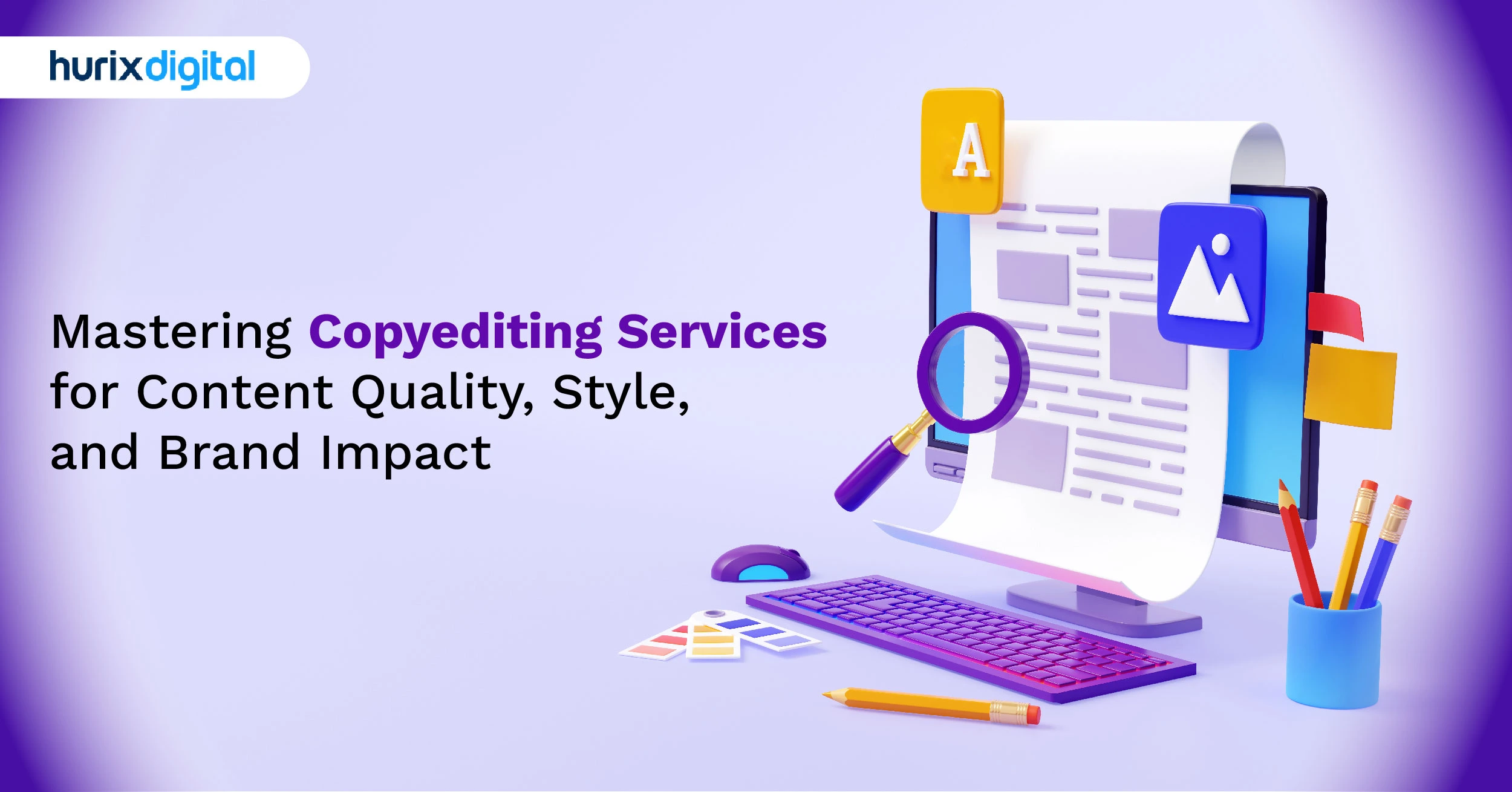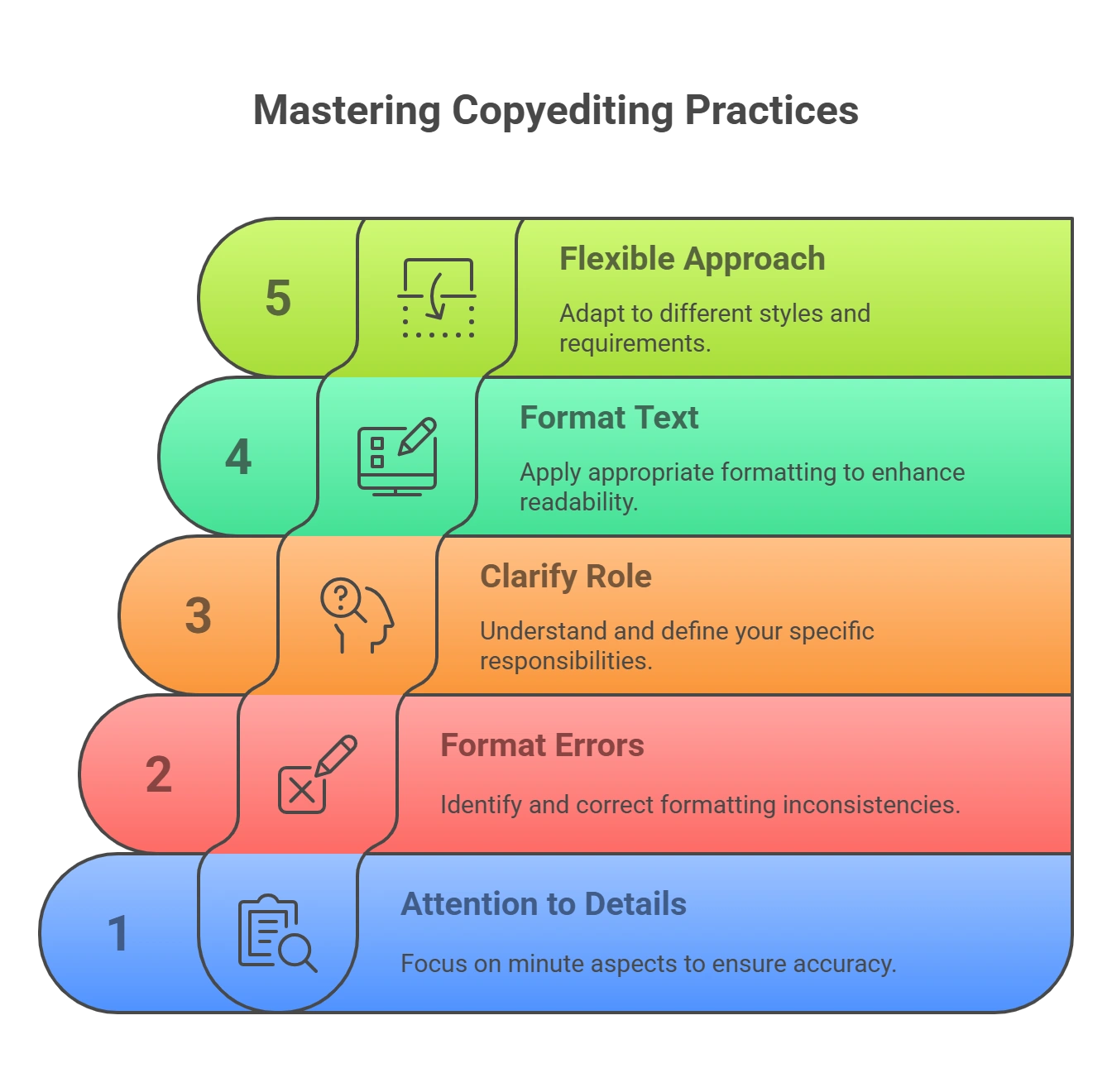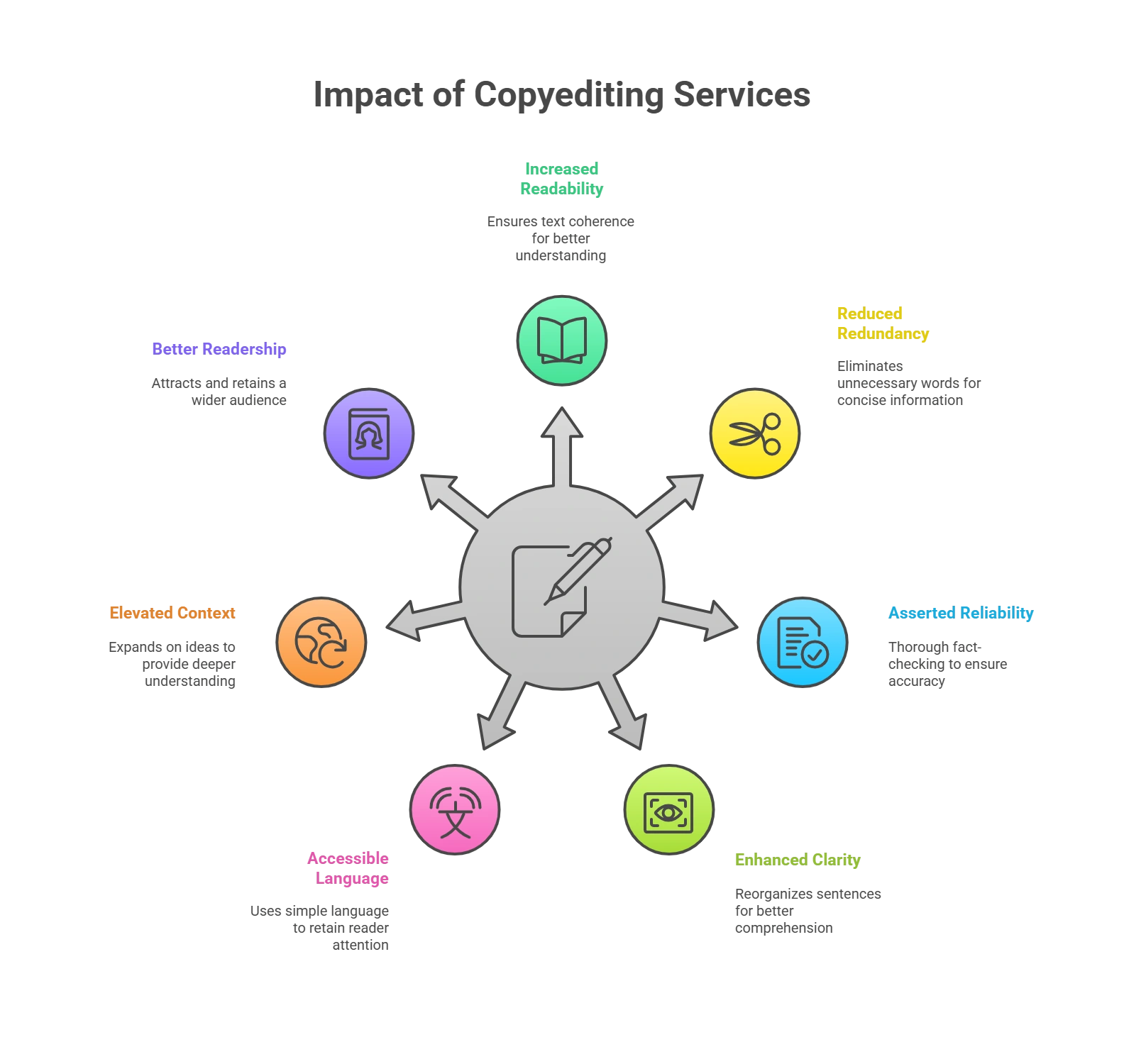
Mastering Copyediting Services for Content Quality, Style, and Brand Impact
Summarize with:
We all know that brand image is crucial for a business’s success and staying ahead of the competition. Customers choose a brand for a reason, and the image plays a prominent role. Even if you have a top-quality product or world-class service, how you maintain your brand image and present it to the audience matters.
That’s why it’s so important to ensure your business has the right look and feel through branding mastery. You must ensure that your images, colors, and fonts are consistent with your brand identity.
- How do you know what fonts work best for your brand?
- What about color schemes?
- And how can you tell if something looks professional or not?
The solution is as simple as it can get. You can hire professional copyediting services and an expert in publishing. Let’s understand how brand typesetting and copyediting can help your brand.
Table of Contents:
- What is Copyediting?
- What are the 5 C’s of Copyediting?
- Levels and Styles of Copyediting
- 5 Best Practices to Understand Copyediting Styles and Levels
- Why Do You Need Copyediting Services?
- When Should You Opt for Copyediting Services?
- How Do Professional Copyediting Services Impact Content Quality?
- Increases Readability by Ensuring Text Coherence
- Reduces Redundancy and Wordiness for Better Dissemination of Information
- Asserts Reliability of the Content by Thorough Fact-Checking
- Enhances Clarity of the Content by Reorganizing Sentences
- Ensures Accessible Language for Retaining the Reader’s Attention
- Elevates Contextual Attributes by Expanding on Ideas
- Develop a Better Target Audience Readership
- Takeaway
What is Copyediting?
Copyediting refers to the process of reviewing text or a piece of content to enhance its flow, clarity, and overall quality. This structured process includes correcting everything from grammar and punctuation to spelling errors and factual accuracy.
Copyediting services aim to ensure that your text adheres to a specific style and level guide to adequately prepare drafts or manuscripts for publication, whether in articles, books, websites, or other formats.
What are the 5 C’s of Copyediting?
Online copyediting is used to identify and correct grammatical, usage, syntax, and punctuation complications as well as mechanical and thematic inconsistencies in a piece of writing. A copyeditor’s main responsibility is to ensure these 5 C’s while editing the content.
- Clear
- Correct
- Concise
- Comprehensible
- Consistency
Levels and Styles of Copyediting
There are multiple levels and styles of proofreading and copyediting, as explained below:
- Basic Copyediting: This style of copyediting focuses primarily on revising basic errors in spelling, grammar, and punctuation.
- Medium Copyediting: As the name suggests, medium copyediting tasks include improving word choice, sentence structure, and more.
- Heavy Copyediting: This level of copyediting involves extensive rewriting and restructuring of text to improve flow and clarity.

5 Best Practices to Understand Copyediting Styles and Levels
Wondering how to improve your text by developing a better understanding of various types of copyediting styles and levels? Read on to know some of the best practices here:
1. Attention to Details
One key skill that copy editors need is attention to detail. They should have a keen eye for various types of copyediting, their levels, styles, and errors, such as a simple misplacement of an apostrophe or comma.
This kind of tedious and time-consuming work often requires copy editors to review the content thoroughly before it is fully proofread and polished. This means combing through a given work and checking to make sure that all the details mentioned are kept consistent, such as characters and descriptions of settings.
To navigate this better, here is the list of elements you need to check or audit to polish a piece of content:
- Grammar: Replace all passive voice sentences with active voice, fix instances of sentence fragments, etc.
- Typos: Find and fix all spelling mistakes.
- Punctuation: Make sure that commas, periods, and other punctuation marks are used in order and correctly.
- Transitions: Look for cases of poor transitions between sections and paragraphs that make reading them awkward.
- Structure: Check if the sentences and paragraphs are of good length and are consistent throughout the content.
- Vocabulary: Ensure that the vocabulary level used in the content remains consistent to prevent readings from being thrown off.
2. Format Errors
Another important priority for a copy editor is to highlight and suggest various errors and corrections, such as grammatical errors, punctuation errors, spelling errors, syntax errors, and more.
While a separate proofreader can tackle these areas easily, a copy editor still needs to monitor and address them as they arise, as they may impact the work’s content.
Likewise, to better understand the best practices in professional copyediting, an editor needs to do thorough research for fact-checking, especially if there is no fact-checker working on a publication dedicatedly. This allows the copy editor to verify the accuracy of dates and events.
3. Clarify and Know Your Role
When you are trying to understand the various levels and styles of copyediting, it is also crucial to know your role and determine the level of copyediting you’re providing.
For instance, if you’re just beginning, it’s best to stick to the more basic responsibilities, such as looking for grammatical, spelling, and syntax errors only.
Likewise, if you have some experience in copyediting and are familiar with the style guides already, it is better to choose a more substantive editing role.
4. Format the Text Appropriately
Once all the edits in the content copy are done, it is important to ensure that they comply with the required formatting standards. For instance, the preferred editing format for novel or magazine copyediting is the Chicago Manual of Style.
Likewise, if it’s a news story, the formatting style needed is the Associated Press Stylebook. In some cases, you may also receive a style sheet, which is a proper template outlining the style of the publication you’re editing for (if applicable).
There are also chances that no formatting standards are required to follow in some cases. During such instances, the copyeditor needs to keep the author’s style consistent.
5. Be Flexible in Approach
Since every publication has its own set of expectations, concerns, and guidelines, copy editors need to be flexible enough to adapt to the requirements.
Copy editors should continually study grammar and stay current on language usage. Several style guides and thesauruses are available to help them further hone their language skills.
Lastly, copyeditors need to value critical feedback to better understand various copyediting styles and levels. This means having someone else look at the copy with an unbiased eye to avoid any errors or mistakes slipping through. Welcome the feedback offered by peers and clients with an open mindset to sharpen your skills.
Why Do You Need Copyediting Services?
The short answer is that you need them to get the best version of your book published.
Every organization in the publishing industry hires copyeditors for the simple reason that each one of them must ensure that the content they publish, be it in the form of a book or on their website, is free of error.
For instance, as an author, you might be well-versed in all the intricacies of grammar, language, semantics, and more, and may think you can also edit your book once you’ve written it. Others, on the other hand, are experts at putting together complex ideas but may still need a second pair of eyes to review their content to ensure it’s worthy of publication.
The truth is, it never hurts to have someone go through your work to bring it in shape, as writers may often miss out on potential errors they may have made. As we mentioned in the previous section, if you’re unsure about ticking all the boxes mentioned in the list of a copyeditor’s scope of work, you need their services.
When Should You Opt for Copyediting Services?
Copyediting is usually the first stage of the prepress process. Authors who decide to self-publish their book usually have to bear all the production costs, which are otherwise taken care of by a publisher if they decide to approach one.
The right time to opt for copyediting services is after you’ve completed your draft. The copyediting stage will be the precursor to your submitting the edited copy to a publishing house for them to evaluate.
However, some publishers offer in-house services that handle the editing process according to the brand’s tone.

How Do Professional Copyediting Services Impact Content Quality?
There is considerably more to copyediting than just checking syntax and grammar. While flawless grammar and spelling are necessary for credible, professional writing, copyediting goes above and beyond to make sure the content is interesting and factual while also supporting your publication’s objectives.
Here are a few ways professional copyediting services warrant valuable and high-quality content that goes a long way.
1. Increases Readability by Ensuring Text Coherence
Copyediting achieves deep content analysis and text coherence. This step evaluates the general structure, idea organization, and writing flow. Professional copywriting services ensure that the intended point of the content is successfully communicated to the reader.
Copyediting enhances the work’s comprehensive readability to pique the reader’s attention in your material by correcting logical flaws.
2. Reduces Redundancy and Wordiness for Better Dissemination of Information
Redundancy can be confusing since it lengthens text instead of improving it. Finding redundant material in your work can be challenging, especially if you have read and reread it extensively. However, copyediting services eliminate redundancy by limiting filler words, avoiding the overuse of qualifiers, and resisting logorrhea.
Copyeditors ensure your ideas can be effectively communicated to the readers through orderly and concise writing.
3. Asserts Reliability of the Content by Thorough Fact-Checking
Writing errors can divert readers and diminish the authority of your information. Copyediting services resolve these problems by ensuring consistency in spelling, punctuation, capitalization, and formatting across the document.
Additionally, academic copyediting incorporates fact-checking to confirm the factual accuracy of the data in the material. This helps maintain the credibility of the written content and avert any potential risks of misinformation.
4. Enhances Clarity of the Content by Reorganizing Sentences
Clarity in writing means being clear and concise for your intended audience. Ideas are effectively communicated in clear writing when there is no room for doubt or uncertainty. It entails speaking clearly and refraining from using jargon that the reader may struggle to comprehend.
A copy editor improves the clarity of the content by rewording or reorganizing unclear sentences. They also fill in gaps in the information to make it more coherent and logical. As a result, there is little chance for readers to become confused, making the work more interesting and entertaining to read.
5. Ensures Accessible Language for Retaining the Reader’s Attention
Reader engagement is paramount as it helps in knowledge-building and academic achievement and boosts overall performance. To ensure reader engagement, copywriting services ensure the reader can build a rapport with the text.
This is achieved by improving the language of the material during copyediting and proofreading. Academic copyediting guarantees clear and appropriate text curated, taking into consideration the target audience. Additionally, it enhances the grammar, brevity, word choice, and sentence structure, producing a more refined output.
6. Elevates Contextual Attributes by Expanding on Ideas
An experienced copyeditor offers an alternative viewpoint to assist you in evaluating the quality of the text. They can identify any gap in relevant information and provide you with better suggestions or alternative perspectives on where to include them.
This enables you to develop and build upon excellent concepts in case of a lack of precision and detail. These elements assist you in honing and improving the overall potential and authenticity of the content.
7. Develop a Better Target Audience Readership
Target audience readership is essential for communicating with the readers and increasing the reach of your content.
Employing expert copyediting services also makes it easier for you to identify common errors. For example, an experienced editor can swiftly alter a document produced in UK English that is meant for a US readership to make it more relevant and fit for the intended audience.
Takeaway
Copyediting is one of the most important prepress procedures for a book’s publishing and success. Whether you’re writing a fiction book or an educational eBook, copyediting services are crucial to ensure your work is published with utmost precision and perfection.
If you are looking for the best copyediting services, contact Hurix Digital. Our products are based on four solid pillars: affordability, subject matter expertise, innovation, and efficiency. Using the newest techniques and technology, our team of experts guarantees that your text will be digitized with excellent quality.
To achieve the intended outcomes, we work with a skilled editorial team that is knowledgeable about language and style. We provide digital prepress services for books, textbooks, journals, and publications to publishers worldwide.
Get in touch with us today!
Summarize with:

Vice President – Content Transformation at HurixDigital, based in Chennai. With nearly 20 years in digital content, he leads large-scale transformation and accessibility initiatives. A frequent presenter (e.g., London Book Fair 2025), Gokulnath drives AI-powered publishing solutions and inclusive content strategies for global clients
 A Space for Thoughtful
A Space for Thoughtful 



